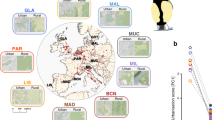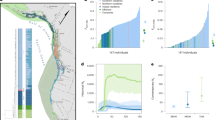Abstract
THE genetic and demographic consequences of population subdivision have received considerable attention from conservation biologists. In particular, losses of genetic variability and reduced viability and fecundity due to inbreeding (inbreeding depression) are of concern1–3. Studies of domestic, laboratory4,5 and zoo populations2,6,7 have shown inbreeding depression in a variety of traits related to fitness. Consequently, inbreeding depression is widely accepted as a fact. Recently, however, the relative impact of inbreeding on the viability of natural populations has been questioned8–10. Work on the cheetah (Acinonyx jubatus), for example, has emphasized the overwhelming importance of environmental factors on mortality in the wild9,10. Here we report that song sparrows (Melospiza melodia) that survived a severe population bottleneck were a non-random subset of the pre-crash population with respect to inbreeding, and that natural selection favoured outbred individuals. Thus, inbreeding depression was expressed in the face of an environmental challenge. Such challenges are also likely to be faced by inbred populations of endangered species. We suggest that environmental and genetic effects on survival may interact and, as a consequence, that their effects on individuals and populations should not be considered independently.
This is a preview of subscription content, access via your institution
Access options
Subscribe to this journal
Receive 51 print issues and online access
$199.00 per year
only $3.90 per issue
Buy this article
- Purchase on Springer Link
- Instant access to full article PDF
Prices may be subject to local taxes which are calculated during checkout
Similar content being viewed by others
References
O'Brien, S. J. et al. Science 227, 1428–1434 (1985).
Proc. Wkshop on Genetic Management of Captive Populations Zoo Biol. 5, 81–238 (1986).
Wilmsen Thornhill, N. The Natural History of Inbreeding and Outbreeding (Univ. Chicago Press, Chicago, 1993).
Wright, S. Evolution and the Genetics of Populations Vol. 3: Experimental Results and Evolutionary Deductions (Univ. Chicago Press, Chicago, 1977).
Falconer, D. S. Introduction to Quantitative Genetics 3rd edn (Longman, London, 1989).
Ralls, K., Brugger, K. & Ballou, J. Science 206, 1101–1103 (1979).
Lacy, R. C., Petric, A. & Warneke, M. in The Natural History of Inbreeding and Outbreeding (ed. Wilmsen Thornhill, N.) 352–374 (Univ. of Chicago Press, Chicago, 1993).
Harcourt, S. Nature 354, 10 (1991).
Caro, T. M. & Laurenson, M. K. Science 263, 485–486 (1994).
Caughley, G. J. anim. Ecol. 63, 215–244 (1994).
Ralls, K., Harvey, P. H. & Lyles, A. M. in Conservation Biology, the Science of Scarcity and Diversity (ed. Soule, M. E.) 35–56 (Sinauer, Sunderland, MA, 1986).
Greenwood, P. J., Harvey, P. H. & Perrins, C. M. Nature 271, 52–54 (1978).
van Noordwijk, A. J. & Scharloo, W. Evolution 35, 674–688 (1981).
Bulger, J. & Hamilton, W. J. III Anim. Behav. 36, 574–578 (1986).
Gibbs, H. L. & Grant, P. Evolution 43, 1273–1284 (1989).
Hoogland, J. Am. Nat. 139, 591–602 (1992).
Templeton, A. R. in Mammalian Dispersal Patterns: the Effect of Social Structure on Population Genetics (eds Chepko-Sade, B. D. & Halpin, Z. T.) 257–272 (Univ. Chicago Press, Chicago, 1987).
Lande, R. & Schemske, D. W. Evolution 39, 24–40 (1985).
Charlesworth, D. & Charlesworth, B. A. Rev. Ecol. Syst. 18, 237–268 (1987).
Barrett, S. C. H. & Charlesworth, D. Nature 352, 522–524 (1991).
Arcese, P., Smith, J. N. M., Hochachka, W. M., Rogers, C. M. & Ludwig, D. Ecology 73, 805–822 (1992).
Tompa, F. S. Auk 88, 753–759 (1971).
Rogers, C. M. et al. Ornis Scand. 22, 387–395 (1991).
Smith, J. N. M., Arcese, P., Hochachka, W. M., Cassidy, A. L. E. V. & Rogers, C. M. Acta XX Congr. Int. Ornith. 1514–1521 (1991).
MacCluer, J. W. et al. J. Hered. 74, 394–399 (1983).
Lande, R. Science 241, 1455–1460 (1988).
Hoffmann, A. A. & Parsons, P. A. Evolutionary Genetics and Environmental Stress (Oxford Univ. Press, Oxford. 1991).
Smith, J. N. M. & Arcese, P. Am. Nat. 133, 830–845 (1989).
Boyce, A. J. J. Hered. 74, 400–404 (1983).
Author information
Authors and Affiliations
Rights and permissions
About this article
Cite this article
Keller, L., Arcese, P., Smith, J. et al. Selection against inbred song sparrows during a natural population bottleneck. Nature 372, 356–357 (1994). https://doi.org/10.1038/372356a0
Received:
Accepted:
Issue Date:
DOI: https://doi.org/10.1038/372356a0
This article is cited by
-
Polyandry and non-random fertilisation maintain long-term genetic diversity in an isolated island population of adders (Vipera berus)
Heredity (2023)
-
Genetic structure and population history in two critically endangered Kaua‘i honeycreepers
Conservation Genetics (2021)
-
Extra Territorial Excursions by European badgers are not limited by age, sex or season
Scientific Reports (2020)
-
Genetics, morphology and diet of introduced populations of the ant-eating Texas Horned Lizard (Phrynosoma cornutum)
Scientific Reports (2019)
-
Inconsistent inbreeding effects during lizard ontogeny
Conservation Genetics (2019)
Comments
By submitting a comment you agree to abide by our Terms and Community Guidelines. If you find something abusive or that does not comply with our terms or guidelines please flag it as inappropriate.



